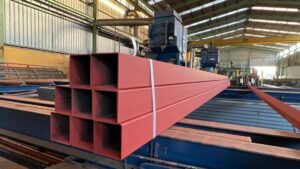
Shanghai-listed Baosteel, during a news conference held Aug. 28, said China’s major steel end-users will continue recovering in the second half of the year, driving China’s crude steel production 4% higher year on year in 2020 to 1.04 billion metric tons – the first time the country’s annual steel production would breach 1 billion mt.
Baosteel expects China’s vehicle production to drop 6% year on year to 24.2 million units in 2020, improving from a 11.8% year-on-year drop in January-July.
The year-on-year decline in home appliances production was also expected to narrow from double digits in H1 2020 to single digits in full-year 2020.
Production of air conditioners, washing machines, freezers and refrigerators over January-July dropped 8% year on year, improving from the 11% drop in January-June, China’s National Bureau of Statistics data showed.
Meanwhile, China’s property and infrastructure sectors will continue to provide firm steel demand in H2, benefiting long steel, as well as flat steel products used in infrastructure projects, such as in bridges, wind mills and hydropower plants, according to Baosteel.
The company expects long steel prices to be well supported through H2, while Q3 is likely to be the strongest quarter in 2020 for the flat steel market.
China’s 14th five-year plan
Baosteel said further development of China’s vehicle manufacturing, especially for new energy vehicles, will be one of the focus points under the 14th five-year plan covering 2021-2025, boosting demand for high strength and ultra-high strength steel products, as well as non-oriented silicon steel, in the next five years.
Baosteel also expects to benefit from the development of high-end manufacturing sectors, such as ultra-high voltage power transmission and transformation, new energy, rail traffic and chemical engineering.
Meanwhile, China will promote a “dual-cycle” economic development pattern in the 2021-2025 period, which would prioritize “internal circulation” to “external circulation,” meaning domestic consumption will gain more policy support.
The “internal circulation” will be beneficial to Baosteel, as 90% of its steel production is currently consumed in the home market, while 10% is for exports, the company said.
Baosteel’s H1 performance
Baosteel’s net profit dropped 37% year on year to Yuan 4 billion ($583 million) over January-June. Its net profit in Q2 increased 60% month on month to Yuan 2.46 billion, but was still about 32% lower year on year.
In H1, its pig iron output dropped 4% year on year to 21.99 million mt, with crude steel output down 3% to 23.46 million mt. The declines were mainly due to the permanent shutdown of its subsidiary Wuhan Iron & Steel’s No. 1 blast furnace with 1.8 million mt/year capacity, in October 2019.
However, Baosteel’s pig iron and crude steel production is set to increase again in 2021 by 2 million mt, due to commissioning of the third blast furnace at Zhanjiang steelworks in southern Guangdong province in July 2021.
The blast furnace will have pig iron capacity of 4.1 million mt/year, and the steelmaking facilities will have production capacities of 4.5 million mt/year of hot-rolled coils and 1.66 million mt/year of cold-rolled coils.
Baosteel said China’s steel industry has remained scattered, and overcapacity has persisted, adding that its parent Baowu Steel Group will continue pushing ahead with its mergers and acquisitions strategy.
On Aug. 21, Baowu had signed an agreement to take a 51% stake in major stainless steel producer Taiyuan Iron & Steel, or TISCO, worth Yuan 14.5 billion ($2.1 billion), which will take its combined crude steel capacity to 111 million mt/year from about 98.5 million mt/year currently.
— Analyst Jing Zhang




